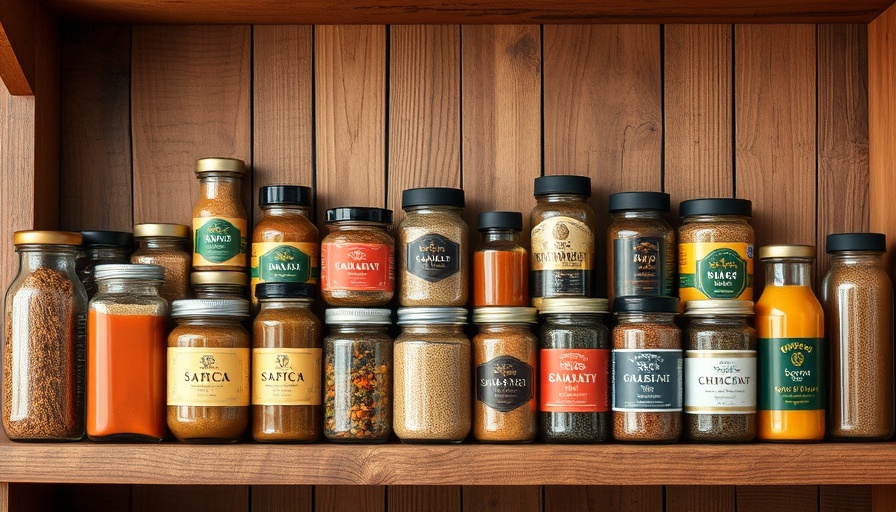
Unlocking a Spice Jar Trick: Elevate Your Cooking Experience
If you've ever wrestled with a spice jar, struggling to release that perfect pinch of flavor while ensuring a clean kitchen, you're not alone. Recently, a delightful kitchen hack has gone viral, compelling many to rethink how they use their spice jars. The secret lies in how we interact with those seemingly mundane lids. Instead of shaking—a method that often results in mess and frustration—simply twist the lid!
Why Are We Just Learning This?
This tip was brought to light by Aaron Turk, a culinary social media influencer, whose exuberant demonstration shocked many home cooks. An Instagram video where he twists his spice jar lids instead of shaking them conveyed sheer disbelief among viewers. Commenters chimed in with their astonishment, expressing grievances about years of splattering messiness in their kitchens. “I’m sorry for all the mean things I’ve said to my spice jars,” one witty follower quipped, showcasing a sense of humor that resonates with frustrations experienced by many.
Simple Yet Effective: A Shift in Kitchen Techniques
This revelation about spice jar lids is not just a fun fact, but a practical insight that holds the potential to enhance the culinary experience. By twisting the lid instead of shaking, the flow of spices becomes more controlled. This technique offers a more even distribution over dishes, whether you're spicing up a stew or finishing a salad. A few turns of the lid allow for precise amounts, minimizing waste while keeping countertops tidy. The impact on cleanliness and ease of use cannot be overstated, especially for home cooks juggling multiple tasks.
Embracing Innovation in Your Kitchen
This simple adjustment highlights an important aspect of effective home cooking: the willingness to embrace innovation, even regarding something as familiar as spice containers. Kitchen tools and techniques are constantly evolving, and adapting to new methods can redefine how we approach meal preparation. Homeowners and aspiring chefs should constantly search for ways to refine their culinary skills, and this spice jar hack is a small but mighty step.
Practical Tips for Implementing the Twist Technique
To start incorporating this twist technique into your cooking routine, consider the following tips:
- Test Your Jars: Before cooking, take some time to practice the twisting motion with different spice jars. This will help get comfortable with how each jar behaves, allowing for an enjoyable cooking experience.
- Organize Your Spice Rack: Ensure that your spices are organized in a way that makes them easy to reach and twist. A tidy spice rack allows for quick access while you’re in the throes of cooking.
- Reconnect with Your Spice Collection: As you begin twisting rather than shaking, take a moment to reconnect with your spices. Explore their aroma and flavors, and utilize this technique to experiment with new recipes.
Why This Matters More than You Think
This spice jar revelation isn't merely about achieving a cleaner kitchen or controlling spice flow. It symbolizes a broader shift towards mindful cooking. In a world replete with fast-paced routines and convenience meals, taking a moment to engage with food preparation encourages creativity and fosters a deeper connection to the meals we create. The appreciation for the small details in cooking can enhance not just the flavor but also the joy of making food.
The Bigger Picture: Culinary Evolution and Accessibility
As more cooks discover innovative techniques and share them across platforms like Instagram, the culinary landscape evolves. Factors like accessibility and sustainability in cooking are critical, especially for families seeking to maximize both flavor and fun in their meal prep routines. Innovative yet simple tricks like the spice jar twist promote an engaging cooking experience that can save time, reduce mess, and ultimately lead to better-tasting dishes.
So the next time you're whipping up a meal, don't forget to give those spice jar lids a twist instead of a shake. Not only will your cooking be more enjoyable, but your kitchen will thank you for it.
For all the home cooks out there, embracing this simple spice jar lid trick could not only improve your culinary techniques but also transform your daily meal preparations. Explore more handy kitchen hacks, and who knows? You might stumble upon your next favorite cooking method!
 Add Row
Add Row  Add
Add 




Write A Comment